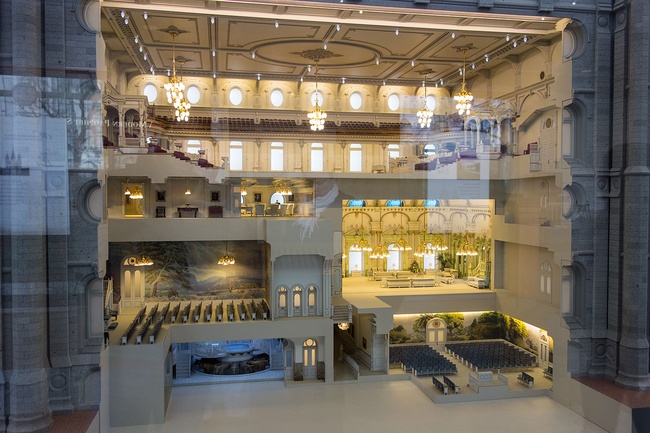 The Salt Lake Temple located in Temple Square, Salt Lake City, Utah. Photo courtesy of the Church of Jesus Christ of Latter-Day Saints.
The Salt Lake Temple located in Temple Square, Salt Lake City, Utah. Photo courtesy of the Church of Jesus Christ of Latter-Day Saints.
About
The Salt Lake Temple, built by the Church of Jesus Christ of Latter-day Saints, is the heart of Temple Square and Church headquarters located in downtown Salt Lake City, Utah. The temple features Gothic and Romanesque elements and has a history dating back to 1847. The temple was announced and the location marked on July 28th, 18471 by Brigham Young, just four days after the first pioneers reached the Salt Lake Valley on July 24th, 1847. The ground was broken on February 14th, 1853 and was dedicated on April 6th, 18932 by Wilford Woodruff after forty years of construction. The dedicatory prayer can be found here. The Salt Lake Temple was the sixth temple completed by the Church of Jesus Christ of Latter-day Saints, and at an astounding 253,000 square feet, is currently the largest temple.
 Groundbreaking ceremony on February 14th, 1853. Photo courtesy of the Church History Library.
Groundbreaking ceremony on February 14th, 1853. Photo courtesy of the Church History Library. Latter-day Saints gathering for the capstone ceremony, April 6th, 1892. Photo courtesy of Charles R. Savage, Utah Historical Society.
Latter-day Saints gathering for the capstone ceremony, April 6th, 1892. Photo courtesy of Charles R. Savage, Utah Historical Society.
Truman O. Angell was appointed as the church architect by Brigham Young, his brother-in-law, on January 26th, 1850, placing him as the head over the Salt Lake Temple plans as well as several other historical buildings in the Utah Territory, such as the Saint George, Utah Temple.
Due to the sacredness of the temple, there are not many interior photos of the Salt Lake Temple and only members of the Church of Jesus Christ of Latter-day Saints with current temple recommends are permitted to enter, but photographs are prohibited. However, the Church of Jesus Christ of Latter-day Saints has over the years released some authorized photographs of the interior. The temple interior includes beautiful elaborate furniture, drapes, and moldings, as well as many paintings and murals full of nature and religious figures, such as Jesus Christ.
Five artists who would later work on the interior murals and paintings traveled to Paris, France to study art at the Académie Julian3. John Hafen and Lorus Pratt proposed to the Church's leaders that they should receive financial aid to attend school in Paris, France, to benefit the Church. Permission was granted in June 1890, and John Hafen, Lorus Pratt, and John B. Fairbanks were soon set apart as missionaries and sent abroad. Edwin Evans and Herman Hugo Haag eventually followed. After completing their missions, the missionaries returned and worked on the art in the Salt Lake Temple, bringing French Impressionist influence from their studies onto the temple's walls.
Model of the Salt Lake Temple interior at a Temple Square visitor center.
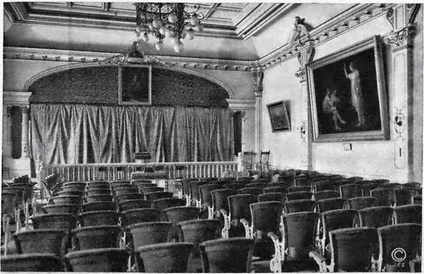 1912 interior photo of the Terrestrial Room in the Salt Lake Temple, from the "House of the Lord" published by the Church of Jesus Christ of Latter-day Saints.
1912 interior photo of the Terrestrial Room in the Salt Lake Temple, from the "House of the Lord" published by the Church of Jesus Christ of Latter-day Saints.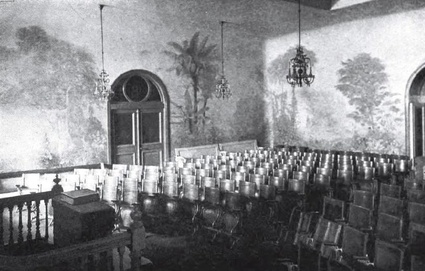 1912 interior photo of the Salt Lake Temple Garden Room, from the "House of the Lord" published by the Church of Jesus Christ of Latter-day Saints.
1912 interior photo of the Salt Lake Temple Garden Room, from the "House of the Lord" published by the Church of Jesus Christ of Latter-day Saints. 1912 interior photo of the Salt Lake Temple baptistry, from the "House of the Lord" published by the Church of Jesus Christ of Latter-day Saints.
1912 interior photo of the Salt Lake Temple baptistry, from the "House of the Lord" published by the Church of Jesus Christ of Latter-day Saints.
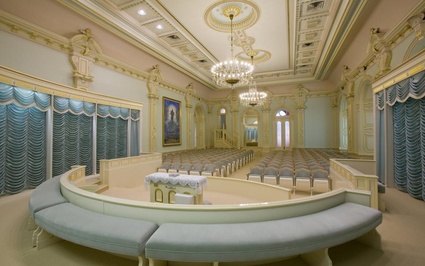 Modern day photo of the Terrestrial Room in the Salt Lake Temple, courtesy of the Church of Jesus Christ of Latter-day Saints.
Modern day photo of the Terrestrial Room in the Salt Lake Temple, courtesy of the Church of Jesus Christ of Latter-day Saints. Modern day photo of the Garden Room in the Salt Lake Temple, courtesy of the Church of Jesus Christ of Latter-day Saints.
Modern day photo of the Garden Room in the Salt Lake Temple, courtesy of the Church of Jesus Christ of Latter-day Saints. Modern day photo of the Salt Lake Temple baptistry, courtesy of the Church of Jesus Christ of Latter-day Saints.
Modern day photo of the Salt Lake Temple baptistry, courtesy of the Church of Jesus Christ of Latter-day Saints.
Construction
The Church's leadership wanted this temple to last, so they ensured the best materials possible were selected from the nearby mountains4. Brigham Young stated that the pioneers should "build not for today nor tomorrow but for all eternity"5. At first, sandstone, a mix of mud and straw, was used to build the temple foundation and was believed to be a sturdy option. However, due to tensions from the Utah War (1857-1858), the pioneers had to bury the foundation to hide the temple. Upon uncovering the foundation after the war, several foundation stones were found cracked. This foundation was redone using quartz monzonite, which is similar to granite, from the Little Cottonwood Canyon about 20 miles away6 and the rest of the temple was completed with this granite-like rock. 2-to-5-ton blocks were hauled from the canyon in wagons pulled by oxen7. It remains unexplained in historical records how the men hoisted the blocks onto the carts. Eventually, in 1870, the arrival of the railroad allowed a train route to be established between the temple site and the canyon, allowing for a more efficient process of granite transportation.
 Men quarry granite for the Salt Lake Temple. Photo by Charles W. Carter, courtesy of the Church History Library.
Men quarry granite for the Salt Lake Temple. Photo by Charles W. Carter, courtesy of the Church History Library.  Granite temple foundation, taken in 1872 by Charles W. Carter, courtesy of the Church History Library.
Granite temple foundation, taken in 1872 by Charles W. Carter, courtesy of the Church History Library.
The Angel Moroni
Atop many Latter-day Saint temples is a 12-foot-5-inch golden statue of the Angel Moroni8, an important Book of Mormon prophet to the members of the Church of Jesus Christ of Latter-day Saints who symbolizes the Church's mission to spread the teachings of Jesus Christ around the world. Cyrus Edwin Dallin sculpted the angel that was placed on the Salt Lake Temple during the capstone ceremony on April 6th, 1892, the final crowning piece for the temple's exterior. The statue resides on the 210-foot central spire on the east side of the temple. The Salt Lake Temple was the first Latter-day Saint temple to receive this statue, and while not a requirement for temple designs, a majority of other Latter-day Saint temples have since been adorned with this same statue.
Renovations
Between 1962-1966, the Salt Lake Temple first closed for renovations to allow for the installation of new heating, plumbing, air conditioning, and electrical systems9. In 1962 and 1963, photographs were taken of the 30-foot foundation which consists of 16 feet of a sandstone sub-foundation and 14 feet of granite.
 The foundation of the Salt Lake Temple is exposed, September 8, 1962. Linden W. Millgate, engineer, inspects footings. Photo courtesy of Deseret News archives.
The foundation of the Salt Lake Temple is exposed, September 8, 1962. Linden W. Millgate, engineer, inspects footings. Photo courtesy of Deseret News archives.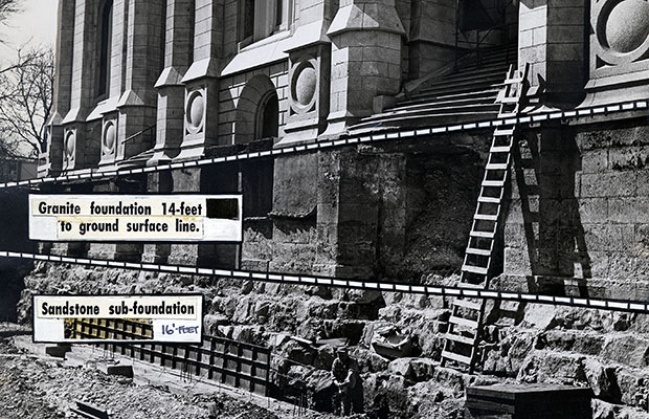 March 30, 1963, picture of the construction site, showing the sandstone sub-foundation to the granite foundations under the main entrance to the Salt Lake Temple. Photo by Ralph T. Clark, Deseret News archives.
March 30, 1963, picture of the construction site, showing the sandstone sub-foundation to the granite foundations under the main entrance to the Salt Lake Temple. Photo by Ralph T. Clark, Deseret News archives.
On December 29th, 2019, the Salt Lake Temple closed for an estimated four years for a second renovation, this time for major structural updates and seismic upgrades to preserve this historic temple10. 98 base isolators are being inserted under and around the foundation, to limit the 187-million-pound temple's motion during a high magnitude earthquake, enabling the temple to withstand up to five times the weight of the temple and to move up to four or five feet in any direction11. This restoration will also restore and refresh the temple's interior to the original Victorian-inspired palette of dark woods, rich colors, and patterned fabrics. All steps taken during the restoration process, inside and out, will include preserving the many historic features of the Salt Lake Temple.
 Perspective view of seismic upgrades for the Salt Lake Temple renovation.
Perspective view of seismic upgrades for the Salt Lake Temple renovation.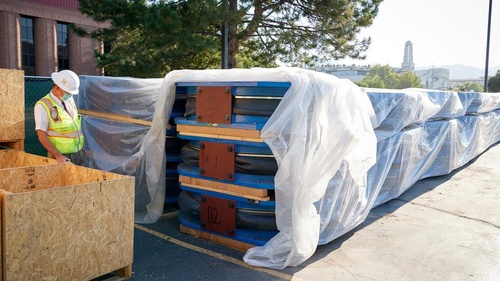 Some of the 98 base isolators awaiting placement under the Salt Lake Temple.
Some of the 98 base isolators awaiting placement under the Salt Lake Temple.
The 2020 Salt Lake City Earthquake
On March 18th, 2020 at 7:09am, a 5.7-magnitude earthquake11 with an epicenter in Magna, Utah, about 15 miles from the Salt Lake Temple, hit Salt Lake City. This was the most severe earthquake to hit Salt Lake City since its founding. Over 600 aftershocks occurred by March 26th, 2020, including two 4.6-magnitude aftershocks that occurred at 8:02am and 1:12pm on March 18th, 2020. On April 14th and 16th, 2020, two 4.2-magnitude aftershocks occurred.
The Salt Lake Temple sustained minimal damage from the earthquake. The Church's newsroom reported that the Angel Moroni had lost its trumpet, and that there was some minor damage to spire stones. Otherwise, no crew members at the site during the earthquake were injured and the temple was safe. The spokesman for the church, Daniel Woodruff, then stated that "this event emphasizes why this project is so necessary to preserve this historic building and create a safer environment for all our patrons and visitors."12
The Angel Moroni atop the Salt Lake Temple missing its trumpet due to the March 2020 earthquake.
The Time Capsule
During the capstone ceremony on April 6th, 1892, a time capsule was placed inside the capstone and remained untouched for 128 years. Over 40,000 people gathered near the temple to witness this historic moment. A journalist atop the temple, there to witness the laying of the capstone, wrote that the capsule contained "books, photos, letters, paper notes, medallions and coins"13. On May 18th, 2020, the Angel Moroni and capstone were removed as a part of the renovation and preservation process, which was escalated due to the earthquake's damage two months earlier. No crowd was present due to the COVID-19 pandemic. On May 20th, 2020, the current Prophet of the Church of Jesus Christ of Latter-day Saints, Russell M. Nelson, and his two counselors, Dallin H. Oaks and Henry B. Eyring, joined a group of conservation experts and stone masons to crack open the capstone and examine the artifacts. Due to the capstone not being insulated from weather, the quality of the artifacts was not expected to be pristine; however, the most important part of the time capsule was to remember the many years of labor, courage, and dedication the early Utah pioneers put into the temple.
The capstone contained a copper plate inscribed with the names of the Church's leaders at the time of the cornerstone's laying on April 6th, 1853 and of the leaders present during the capstone ceremony on April 6th, 1892, as well as approximately 400 coins. The types of coins consisted of pennies, nickels, and dimes, as well as some quarters, six-pence, three-pence, half-dimes, and three-cent pieces. According to the Salt Lake Herold Republican report, when the capstone was minutes away from being placed, "every man on the platform eagerly thrust out a dime or a nickel or a quarter of a dollar” into the capstone14.
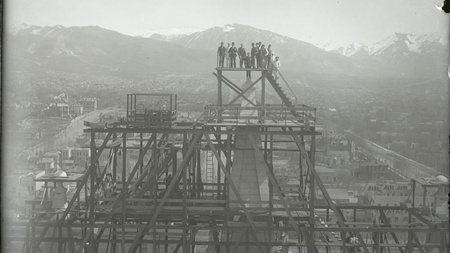 Workers atop the Salt Lake Temple awaiting the placement of the capstone. Photo courtesy of the Church of Jesus Christ of Latter-day Saints.
Workers atop the Salt Lake Temple awaiting the placement of the capstone. Photo courtesy of the Church of Jesus Christ of Latter-day Saints. The crowd watching the capstone ceremony on April 6th, 1892. Photo courtesy of the Church of Jesus Christ of Latter-day Saints.
The crowd watching the capstone ceremony on April 6th, 1892. Photo courtesy of the Church of Jesus Christ of Latter-day Saints.
 The Angel Moroni and capstone being removed on May 18th, 2020 from the Salt Lake Temple. Photo courtesy of the Church of Jesus Christ of Latter-day Saints.
The Angel Moroni and capstone being removed on May 18th, 2020 from the Salt Lake Temple. Photo courtesy of the Church of Jesus Christ of Latter-day Saints.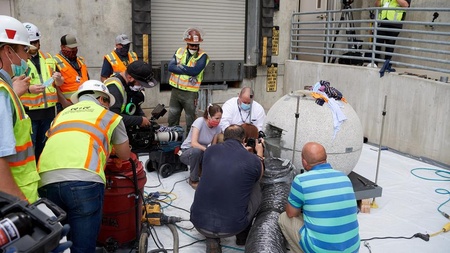 Conservators and stone masons opening the capstone. Photo Courtesy of the Church of Jesus Christ of Latter-day Saints.
Conservators and stone masons opening the capstone. Photo Courtesy of the Church of Jesus Christ of Latter-day Saints.
The books, letters, and notes were significantly water-damaged. Twelve books were found, and seven were identified as the following:
- Parley P. Pratt’s A Voice of Warning
- Parley P. Pratt’s Key to the Science of Theology
- A copy of the Book of Mormon (probably an 1880s or 1890s edition)
- The Pearl of Great Price (a part of the Church’s scriptural canon since 1880)
- The Martyrs: A Sketch of the Lives and a Full Account of the Martyrdom of Joseph and Hyrum Smith
- The Holy Bible
- Letters exchanged between Latter-day Saint theologian Orson Spencer and the Reverend William Cromwell
A report by the Salt Lake Herald15 mentions a hymn book and a compendium, which were not identified among the remaining books present. The Herald also reported that the photos included were cabinet cards of important Church leaders such as Joseph and Hyrum Smith, Brigham Young, John Taylor, Wilford Woodruff, George Q. Cannon, and Joseph F. Smith, as well as the Salt Lake Temple. However, they unfortunately were laminated together over time within the concrete and are currently unidentifiable.
 Dallin H. Oaks, President Russell M. Nelson, and Henry B. Eyring observing some of the artifacts with Emiline Twitchell, a conservator at the Church History Library. Photo courtesy of the Church of Jesus Christ of Latter-day Saints.
Dallin H. Oaks, President Russell M. Nelson, and Henry B. Eyring observing some of the artifacts with Emiline Twitchell, a conservator at the Church History Library. Photo courtesy of the Church of Jesus Christ of Latter-day Saints.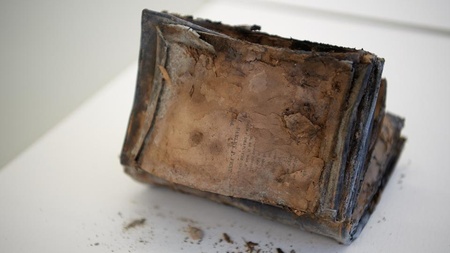 A book "Voice of Warning" by Parley P. Pratt from the time capsule. Photo courtesy of the Church of Jesus Christ of Latter-day Saints.
A book "Voice of Warning" by Parley P. Pratt from the time capsule. Photo courtesy of the Church of Jesus Christ of Latter-day Saints.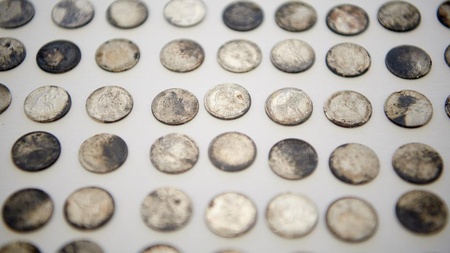 Coins found in the time capsule. Photo courtesy of the Church of Jesus Christ of Latter-day Saints.
Coins found in the time capsule. Photo courtesy of the Church of Jesus Christ of Latter-day Saints.  President Russell M. Nelson looking into the time capsule. Photo courtesy of the Church of Jesus Christ of Latter-day Saints.
President Russell M. Nelson looking into the time capsule. Photo courtesy of the Church of Jesus Christ of Latter-day Saints.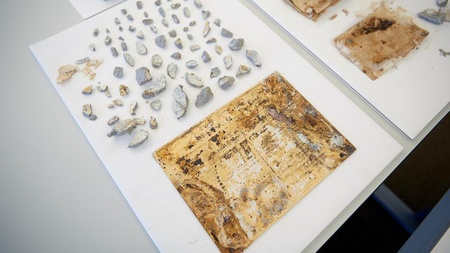 The copper plate found in the time capsule with early Church leaders' names inscribed. Photo courtesy of the Church of Jesus Christ of Latter-day Saints.
The copper plate found in the time capsule with early Church leaders' names inscribed. Photo courtesy of the Church of Jesus Christ of Latter-day Saints.
References:
1. https://www.templesquare.com/blog/interesting-facts-you-didnt-know-about-the-salt-lake-temple/
2. https://www.churchofjesuschrist.org/temples/details/salt-lake-temple?lang=eng
6. Heber C. Kimball, Journal History, in Deseret News, Oct. 9, 1852, 1.
7. https://utahstories.com/2011/08/little-cottonwood-canyon/
8. https://newsroom.churchofjesuschrist.org/article/angel-moroni-statues-on-temples
9. https://newsroom.churchofjesuschrist.org/article/plans-unveiled-salt-lake-temple-renovation
10. https://newsroom.churchofjesuschrist.org/article/salt-lake-temple-renovation-update-september-2020
11. https://www.usgs.gov/news/m57-earthquake-felt-near-salt-lake-city-ut
12. https://newsroom.churchofjesuschrist.org/article/salt-lake-temple-utah-earthquake
13. https://newsroom.churchofjesuschrist.org/article/salt-lake-temple-capstone-opened-2020

